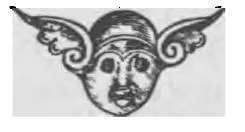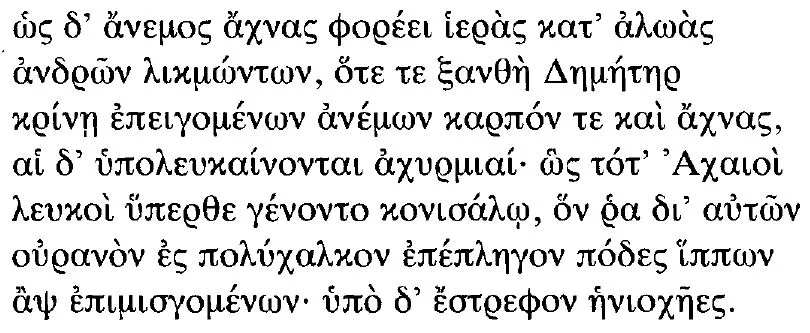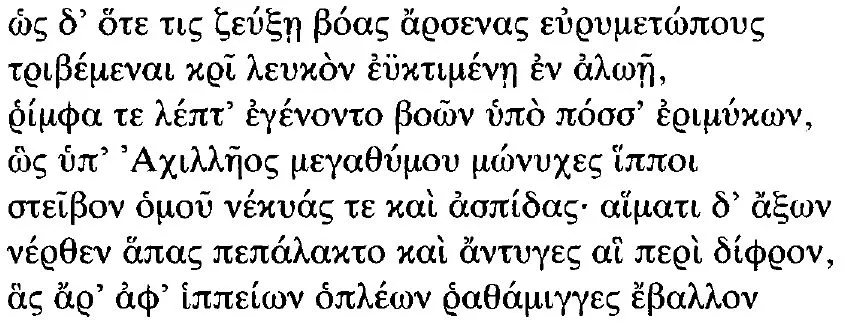THE EPIC DISTANCE
The distinctness of the poetic figures in the Iliad, due in part to the structure of the epic simile itself and to the temporal distance of the poet from the events he describes, generates and maintains what is often called the epic distance. The narrator is set at such a remove from his story that his perspective more closely resembles that of the gods than that of the human actors.1 Although this divine perspective seems clearest in those moments when the poet demonstrates his foreknowledge of the plot, it is also revealed in certain of the similes in which the act of comparison itself requires a near-divine point of view. The first of the threshing images in the Iliad suggests that the act of simile-making itself leads Homer and his listeners to adopt the perspective of the gods, for the audience is asked to think of the Achaeans as chaff:
(V, 499–505)
As when along the hallowed threshing floors the wind scatters
chaff, among men winnowing, and fair-haired Demeter
in the leaning wind discriminates the chaff and the true grain
and the piling chaff whitens beneath it, so now the Achaians
turned white underneath the dust the feet of the horses
drove far into the brazen sky across their faces
as they rapidly closed and the charioteers wheeled back again.
While both rural and martial scenes bring to mind hot, dry, dusty days, the peacefulness of the threshing scene contrasts with the fury of the fight that makes warriors resemble chaff. The lovely Demeter brings a special divinity to the hallowed threshing floors (hieras . . . aloas), a divine capacity for sorting grain and chaff.2 This double figuration—a divine personification of human deeds raised at the moment of comparison itself and calling attention to the figurative movement—points in turn to the goddess’ activity, for only from such a point of view could the aesthetic value of the war scene—the beauty in the violence—be perceived. Demeter’s sorting, her heightened capacity to tell the difference between what is productive and what is not, becomes also a paradigm for the poetic virtue of perceiving differences, of separating, while her presence in figurative form suggests indirectly that the similarities between men and chaff can only be imagined from a divine perspective. The simile suggests both that the bringing of meaning to war through such poetic imagery puts the audience in the position of divine onlookers, and that such poetic transformation of violence into art—a transformation that occurs at the moment of seeing a connection between these dissimilar scenes—is itself a divine gesture, gaining authority through its connection to the divine (which is in turn, itself, a part of the poetic figuration) and requiring first a paradigmatically divine capacity to distinguish the productive and the nonproductive. The divine perspective, in short, allows both the poetic imagery to work and the simile to cohere; it allows the poet to transform war into song—and thereby separates it out, winnows it—for aesthetic contemplation as a beautiful event through which heroes gain immortal fame.
Such striking poetic allegories of the separation and juxtaposition of aesthetics and action magnify the epic distance by being themselves already so resolutely aestheticized, and hence by putting the audience at a protective double distance from the violence of heroic action. When Menelaos is wounded, for example, Homer’s comparison draws his listeners’ attention away from the wound toward the separate space of civilization and its artifacts. After Athena kindly brushes the arrow away from its more fatal course, it grazes Menelaos’s skin under the corselet. Homer spends seven lines describing the arrow as it plunges through Menelaos’s war-belt, but as soon as the dark blood rushes forth, he shifts his attention:
(IV, 141–47)
As when some Maionian woman or Karian with purple
colors ivory, to make it a cheek piece for horses;
it lies away in an inner room, and many a rider
longs to have it, but it is laid up to be a king’s treasure,
two things, to be the beauty of the horse, the pride of the
horseman:
so, Menelaos, your shapely thighs were stained with the color
of blood, and your legs also and your ankles beneath them.
The move from considering the blood rushing forth to picturing the beautiful ivory cheek piece occurs disconcertingly quickly, with some of the speed of the blood itself, and the scene in all its details seems intended to turn attention—like Athena turning aside the arrow—from the literal impact of the wound. The simile, for instance, transforms the wound by treating it also as an aesthetic object: the emphasis on the beauty of Menelaos’s thighs (they are well shaped: mēroi euphuees) and the use of the verb miaino (mianthēn is the epic aorist passive of miainō), which means both “to paint over, stain, dye, color” and “to stain, defile or soil” (a dual sense that Lattimore has attempted to catch in his translation “stained with the color of blood”), both give the wound an artistic quality, as does the more straightforward comparison to the well-made artifact, stained with dye of the color of blood. For listeners and readers, the comparison subtly reminds us, the wound is an object of art to be contemplated in part for its beauty.3
Neither Agamemnon nor Menelaos shares this poetic perspective on the wound, however:
(IV, 148–52)
Agamemnon the lord of men was taken with shuddering
fear as he saw how from the cut the dark blood trickled downward,
and Menelaos the warlike himself shuddered in terror;
but when he saw the binding strings and the hooked barbs outside
the wound, his spirit was gathered back into him.
Although the wound is not fatal, Menelaos is frightened and Agamemnon groans heavily (line 153). They are fighting a war that we, like the gods, are watching, and necessarily we sympathize at the same time that we stand aside and enjoy the story. This simile, then, makes the audience or readers briefly take the point of view from which the war seems painful but beautiful, a figurative move that deflects attention to the epic distance, displacing the violence and transmuting the war scene into a source of aesthetic contemplation.4
By using such similes to highlight and increase the epic distance, Homer thus seems to give the audience a different, wider vision of the action.5 The warriors themselves have no access to this larger expansive world, and the distinctness of action and poetic figure limits the range of meanings that the participants in the war are free to assign to their actions, in particular to their own death. As they die, the heroes hope for a kleos (“glory” or “fame”) that their deaths cut them off from enjoying or knowing.
The heroic action in the Iliad—heroic anger, suffering, and warfare, and the ethical questions they raise—can be said to include all the events of which the human characters in the poem are aware and all the scenes in which they take part. The representation of the action occurs through the medium of a highly traditional discourse, which, in its commitment to an epic sense of destiny in which death can never be escaped, serves to challenge the values asserted in the several, very different figurative discourses. 6 The meanings attached to the war scenes, in contrast to those expressed through this discourse of fate, and in contrast to those felt by the characters, are brought to the poem through the poetic figures: this symbolic or figurative dimension of the story is constituted by the epic similes and other uses of poetic imagery, by Homer’s digressions on the past or on the gods, by his foreboding warnings and proleptic laments (and in other instances in which the poem reveals its own distinct temporality), by ecphrases of all kinds, by any moment in which he calls attention to the act of narration, and by the formal patterning of the poem through which its symbolic shape is felt.7 The few moments when characters (like Achilles) are self-reflective fall into an intermediate category and are often figured by a conversation with a god: these intermediate moments often seem to be consonant with the action’s symbolic or interpretive attributes, but finally do not remove the characters from their mortal predicament. Poetic figures provide throughout the Iliad the means by which the poet (and the heroic tradition) appropriates and explains the violence on the Trojan plain, and to this end they bring to the poem a dimension that remains distinct from the story of the war. The ironic distance between action and figure also points, then, to the difference between the epic narrative and the implicit allegory of its production, which tells of the poem’s efforts to shape significance from the action it represents, and of the ideological stake of the oral tradition in attributing social and aesthetic value to heroic experience.8
The human characters in the story are thus by definition unaffected by Homer’s figurative and metanarrative gestures. The perspective of the bard and audience or readers is far from that of the participants in the fight, and the epic reflects on and exploits that difference. During the tug-of-war over Patroklos’s body (see XVII, 389–95), for instance, Homer presents his audience with the image of people standing in a circle pulling on the hide of a great ox to make it into leather, but no warrior thinks of this image. Indeed, the poem stresses that the warriors’ minds are taken up by the battle:
(VII, 395–98)
the hearts of the Trojans were hopeful
to drag him away to Ilion, those of the Achaeans
to get him back to the hollow ships. And about him a savage
struggle arose.
Whatever the effect on the audience, the simile that compares the fight over Patroklos’s body to the stretching of an oxhide does not shift the focus of the soldiers’ attention or change the direction of events—nor, indeed, is it clear how it could. The comparison is directed solely toward the audience : it makes a poetic statement that neither enters into nor reflects the fictional experience of the warriors, nor therefore represents an interpretation of events possible from the standpoint of battle.9
The narrowness of the warrior’s focus is made especially clear in another of the threshing similes, which again momentarily urges the listeners to consider human action from a divine viewpoint, while Achilles persists in an obsessive, even daemonic battle-lust (like the heroic fury, or lussa, that possesses him in XXI, 542):
(XX, 495-503)
Or as when a man yokes male broad-foreheaded oxen
to crush white barley on a strong-laid threshing floor, and rapidly
the barley is stripped beneath the feet of the bellowing oxen,
so before great-hearted Achilleus the single-foot horses
trampled alike dead men and shields, and the axle under
the chariot was all splashed with blood and the rails which encircled
the chariot, struck by flying drops from the feet of the horses,
from the running rims of the wheels. The son of Peleus was
straining
to win glory, his invincible hands spattered with bloody filth.
Achilles resembles the farmer since the men crushed by his chariot are as inconsequential to him as are the individual kernels to the farmer; yet this simile, like the Demeter simile discussed above, is most striking for the con...









